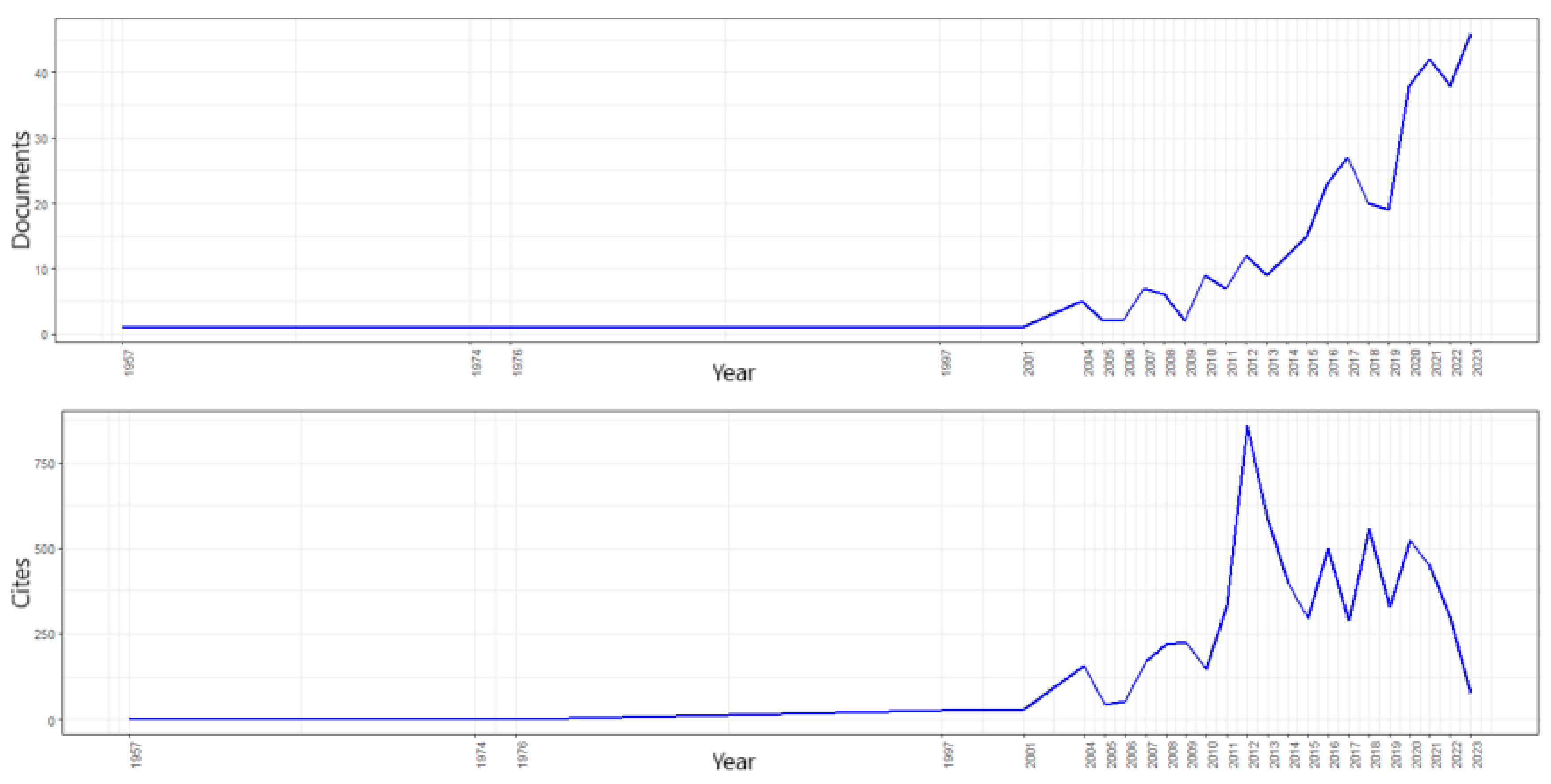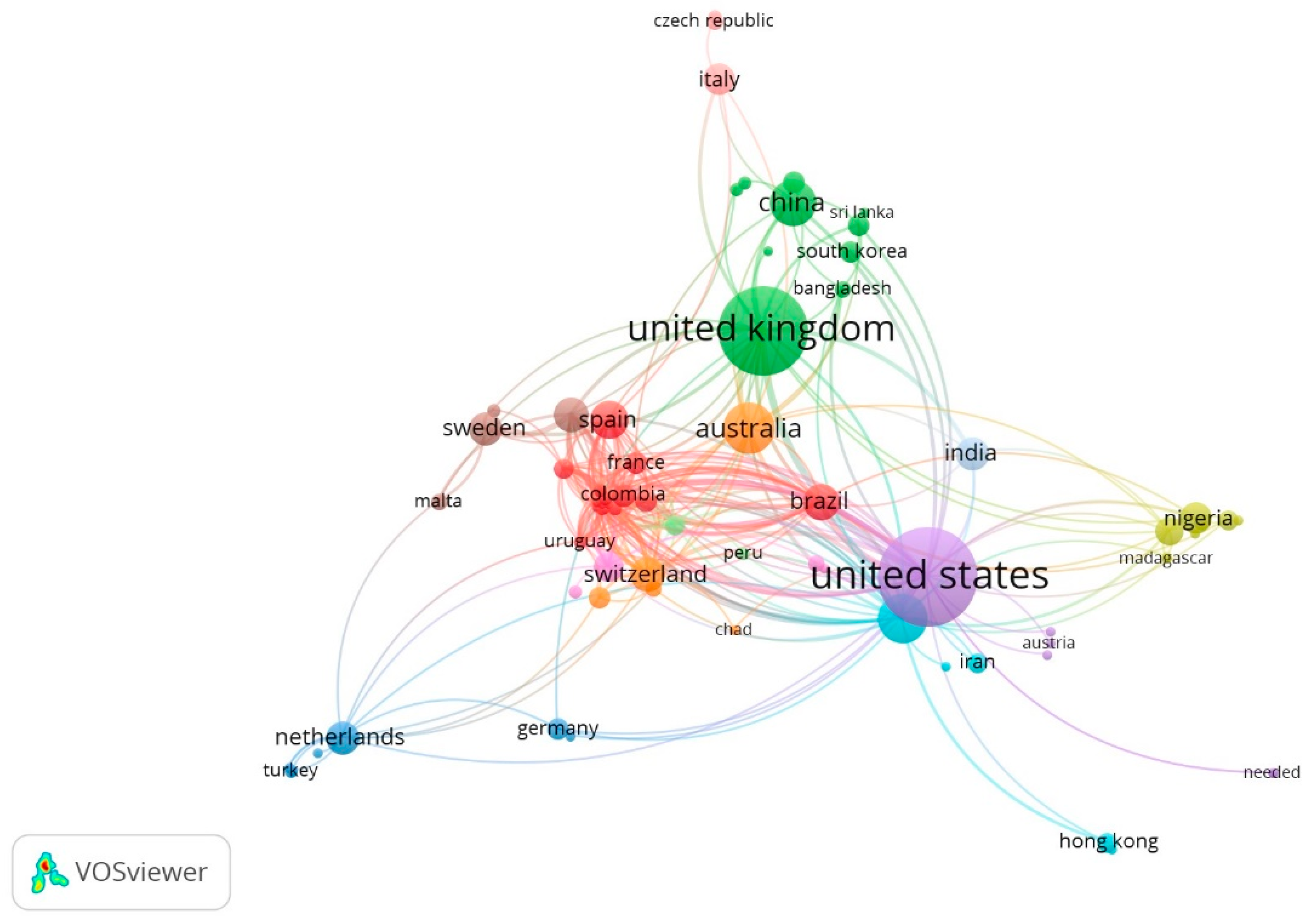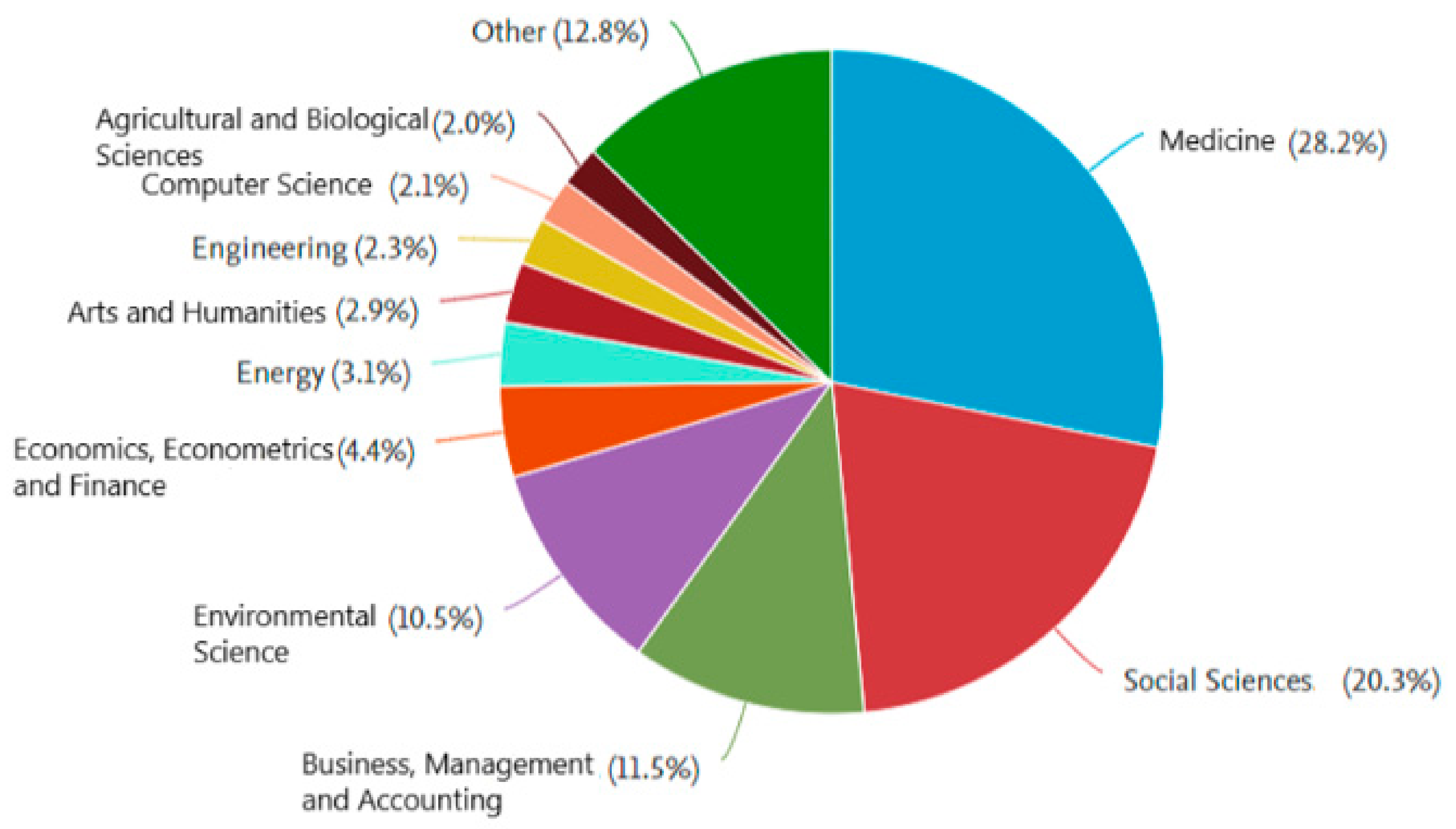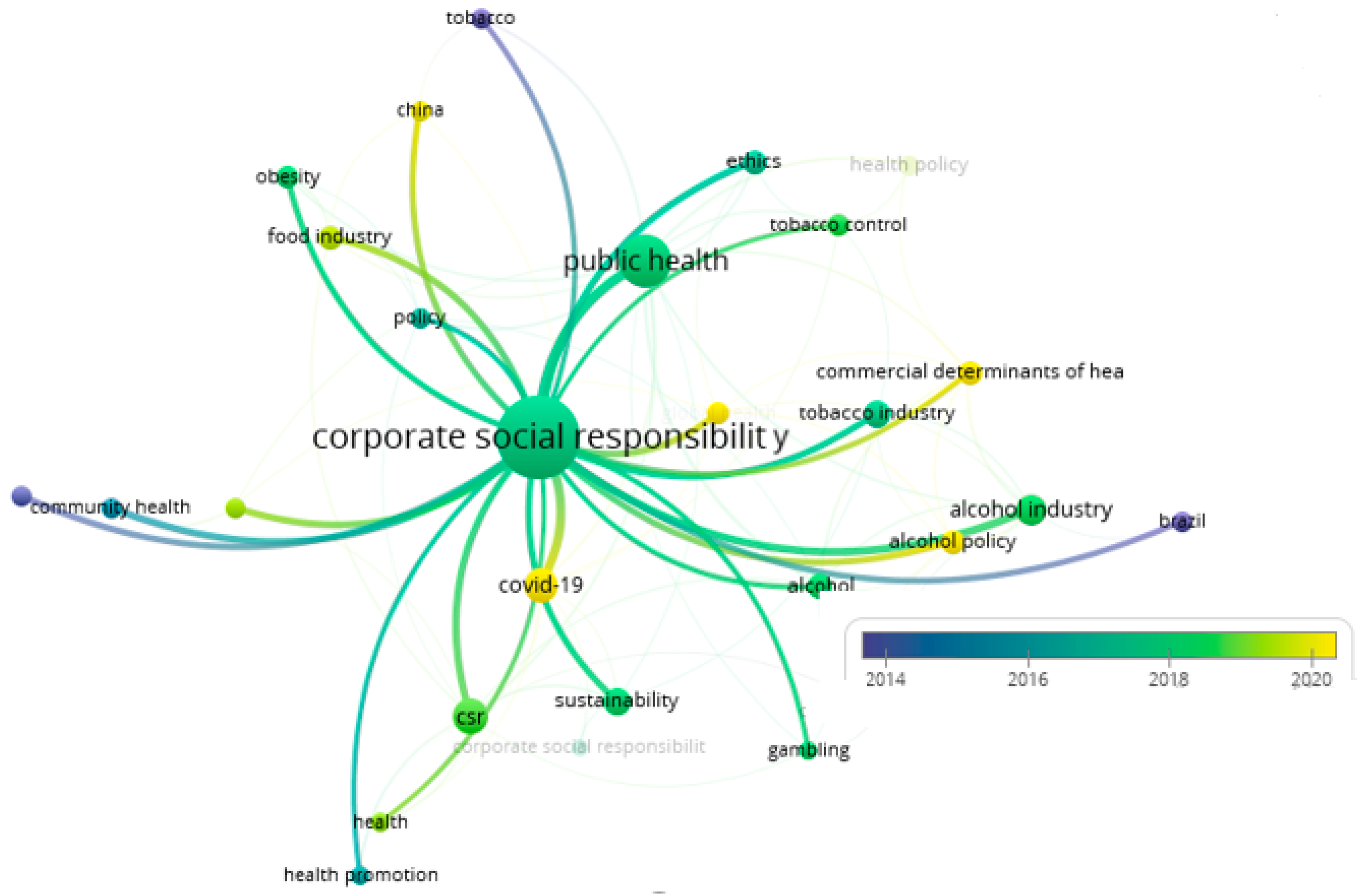Bibliometric Analysis of Corporate Social Responsibility and Its Impact on Community Health
Abstract
1. Introduction
Theoretical Framework
2. Methodology
2.1. Definition of Public Health and Its Impact
2.2. Database Selection
2.3. Definition of Terms and Search Equation
2.4. Initial Search, Inclusion, and Exclusion of Documents
2.5. Content Analysis of the Most Influential Articles
2.6. Analysis of Results
- Publication and Citation Trends: Evaluation of the growth and impact of CSR-public health research over time.
- Country and Institutional Contributions: Identification of leading research nations and collaborative networks.
- Thematic Area Contributions: Analysis of research distribution across fields such as medicine, social sciences, and business.
- Keyword Mapping: Visualization of key research themes and their evolution.
3. Results
3.1. Productivity and Citation Analysis
3.2. Country Contributions and International Collaborations
3.3. Analysis of the Contributions of the Main Thematic Areas
3.4. Keyword Mapping
4. Discussion
4.1. Implications for the Body of Knowledge
4.2. Identified Trends
4.3. Synthesis of Key Trends in the Literature
4.3.1. Key Transformations
4.3.2. Integration with Global Sustainability Goals
- Reducing Carbon Footprints: Many companies have implemented sustainability programs to minimize environmental impact, recognizing the direct link between pollution and community health.
- Ethical Sourcing and Responsible Supply Chains: There is a growing emphasis on ethical sourcing practices, particularly in the food and beverage industry, to reduce health risks associated with harmful additives and unsustainable agricultural practices.
- Community-Based Wellness Initiatives: Organizations are investing in health education, disease prevention campaigns, and access to medical services in underserved communities.
5. Conclusions
5.1. Theoretical Contributions
5.2. Practical Implications
5.3. Practical Recommendations
- Strengthen CSR-Driven Public Health Policies: Policymakers should develop frameworks that incentivize businesses to implement CSR initiatives aligned with public health priorities. These policies should include clearer accountability mechanisms to ensure meaningful contributions rather than superficial branding.
- Develop Standardized Metrics for CSR Impact Assessment: To improve transparency, there is a need to create globally recognized metrics for measuring the actual health benefits of CSR initiatives. This will allow businesses, researchers, and regulators to track long-term outcomes effectively.
- Encourage Industry-Specific CSR Strategies: Different industries require tailored CSR approaches. Companies in sectors such as pharmaceuticals, food production, and manufacturing should align their CSR initiatives with public health concerns unique to their field.
- Promote Cross-Sector Collaboration: Governments, corporations, and civil society organizations should work together to create multi-stakeholder initiatives that leverage CSR for health promotion. Public–private partnerships can enhance the scalability and effectiveness of CSR-driven programs.
- Enhance Transparency and Consumer Awareness: Companies should prioritize transparent reporting on their CSR initiatives, ensuring that consumers can make informed choices. Third-party certifications and independent audits can reinforce credibility and accountability in CSR efforts.
5.4. Identified Gaps in the Literature
- Measurement of CSR Impact: There is a lack of standardized methods to quantify the tangible health benefits of CSR initiatives, making it difficult to assess their effectiveness.
- Longitudinal Studies: Most studies focus on short-term CSR impacts, with limited research on how these initiatives contribute to sustainable community health over time.
- Geographical and Industry-Specific Insights: Research is disproportionately concentrated in developed economies, with fewer studies examining CSR’s role in public health within emerging markets and specific industries such as fast fashion, technology, and agriculture.
5.5. Recommendations for Future Research
- The Long-Term Effects of CSR Initiatives on Community Health—Assessing sustainability and real impact beyond corporate branding.
- The Role of Regulatory Frameworks in Shaping CSR Practices—Particularly in industries with high public health implications such as alcohol, tobacco, and processed foods.
- CSR Strategies in Emerging Economies—Understanding how economic development, governance, and cultural expectations shape corporate responsibility dynamics.
- Interdisciplinary Approaches—Integrating insights from public health, economics, and business ethics to develop a more comprehensive framework for assessing CSR’s contribution to sustainable development and social well-being.
Author Contributions
Funding
Institutional Review Board Statement
Informed Consent Statement
Data Availability Statement
Conflicts of Interest
References
- Kuokkanen, H.; Sun, W. Willingness to Pay for Corporate Social Responsibility (CSR): Does Strategic CSR Management Matter? J. Hosp. Tour. Res. 2024, 48, 657–670. [Google Scholar] [CrossRef]
- Anaf, J.; Baum, F.; Fisher, M.; Haigh, F.; Miller, E.; Gesesew, H.; Freudenberg, N. Assessing the health impacts of transnational crporations: A case study of Carlton and United Breweries in Australia. Glob. Health 2022, 18, 80. [Google Scholar] [CrossRef]
- Duong, C.D. Environmental corporate social responsibility initiatives and the attitude-intention-behavior gap in green consumption. Soc. Responsib. J. 2023, 20, 305–325. [Google Scholar] [CrossRef]
- Carroll, A.B. Corporate Social Responsibility: Evolution of a Definitional Construct. Bus. Soc. 1999, 38, 268–295. [Google Scholar] [CrossRef]
- Wood, D.J. Corporate Social Performance Revisited. Acad. Manag. Rev. 1991, 16, 691–718. [Google Scholar] [CrossRef]
- Dyllick, T.; Hockerts, K. Beyond the Business Case for Corporate Sustainability. Bus. Strategy Environ. 2002, 11, 130–141. [Google Scholar] [CrossRef]
- Porter, M.; Kramer, M. The Big Idea: Creating Shared Value. How to Reinvent Capitalism—And Unleash a Wave of Innovation and Growth. Harv. Bus. Rev. 2011, 89, 62–77. [Google Scholar]
- Suchman, M. Managing Legitimacy: Strategic and Institutional Approaches. Acad. Manag. Rev. 1995, 20, 571–610. [Google Scholar] [CrossRef]
- Donaldson, T.; Preston, L.E. The Stakeholder Theory of the Corporation: Concepts, Evidence, and Implications. Acad. Manag. Rev. 1995, 20, 65–91. [Google Scholar] [CrossRef]
- Riggin, B.; Danylchuk, K.; Gill, D.; Petrella, R. Social impact of a corporate social responsibility initiative. Sport Bus. Manag. Int. J. 2019, 9, 344–362. [Google Scholar] [CrossRef]
- Rela, I.Z.; Awang, A.H.; Ramli, Z.; Rusdan, M.; Mappasomba, M.; Nikoyan, A. Conceptual model of corporate social responsibility impact on community well-being. Entrep. Sustain. Issues 2020, 8, 311–323. [Google Scholar] [CrossRef] [PubMed]
- Gómez, L.; Jacoby, E.; Ibarra, L.; Lucumí, D.; Hernandez, A.; Parra, D.; Florindo, A.; Hallal, P. Sponsorship of physical activity programs by the sweetened beverages industry: Public health or public relations? Rev. Saude Publica 2011, 45, 423–427. [Google Scholar] [CrossRef] [PubMed]
- Millar, J.S. The corporate determinants of health: How big business affects our health, and the need for government action! Can. J. Public Health 2013, 104, e327–e329. [Google Scholar] [CrossRef]
- Monachino, M.S.; Moreira, P.K. CSR: A catalyst for corporate contribution to global health governance?: A case study from the pharmaceutical industry. Hygiea Int. 2016, 12, 73–91. [Google Scholar] [CrossRef]
- Lomachynska, I.; Khalieieva, D.; Shmagina, V. Corporate social responsibility as a tool for ensuring socio-economic security and social inclusion. Mark. Econ. Mod. Manag. Theory Pract. 2023, 21, 75–96. [Google Scholar] [CrossRef]
- Agwu, E. Corporate Social Responsibility as an Organizational Tool for Competitive Advantage. Int. J. Strateg. Decis. Sci. (IJSDS) 2021, 12, 37–51. [Google Scholar] [CrossRef]
- Hansen, J.M.; McDonald, R.E.; Hatfield, H. Exploring market orientation versus finance orientation effects on perceived CSR motivations and outcomes using resource-advantage (R-A) theory. J. Bus. Res. 2023, 164, 113977. [Google Scholar] [CrossRef]
- Geng, L.; Cui, X.; Nazir, R.; Binh An, N. How do CSR and perceived ethics enhance corporate reputation and product innovativeness? Econ. Res.-Ekon. Istraž. 2022, 35, 5131–5149. [Google Scholar] [CrossRef]
- Crocetti, A.C.; Cubillo, B.; Lock, M.; Walker, T.; Hill, K.; Mitchell, F.; Paradies, Y.; Backholer, K.; Browne, J. The commercial determinants of Indigenous health and well-being: A systematic scoping review. BMJ Glob. Health 2022, 7, e010366. [Google Scholar] [CrossRef]
- Palazzo, G.; Richter, U. CSR Business as Usual? The Case of the Tobacco Industry. J. Bus. Ethics 2005, 61, 387–401. [Google Scholar] [CrossRef]
- Deephouse, D.; Suchman, M. Legitimacy in Organizational Institutionalism. In The Sage Handbook of Organizational Institutionalism; Sage: Thousand Oaks, CA, USA, 2008; Volume 49. [Google Scholar] [CrossRef]
- Freeman, R.; Mcvea, J. A Stakeholder Approach to Strategic Management. In The Blackwell Handbook of Strategic Management; Wiley: New York, NY, USA, 2001. [Google Scholar] [CrossRef]
- Clarkson, M.B.E. A Stakeholder Framework for Analyzing and Evaluating Corporate Social Performance. Acad. Manag. Rev. 1995, 20, 92–117. [Google Scholar] [CrossRef]
- Indahsari, C.L.; Hermanto, B.; Herawaty, T. Systematic Mapping Study Brand Identification and Brand Loyalty in Scopus Database. Eur. J. Bus. Manag. Res. 2023, 8, 20–27. [Google Scholar] [CrossRef]
- Vagelas, I.; Leontopoulos, S. A Bibliometric Analysis and a Citation Mapping Process for the Role of Soil Recycled Organic Matter and Microbe Interaction due to Climate Change Using Scopus Database. AgriEngineering 2023, 5, 581–610. [Google Scholar] [CrossRef]
- Winslow, C.E. The Untilled Fields of Public Health. Science 1920, 51, 23–33. [Google Scholar] [CrossRef] [PubMed]
- Turnock, B.J. Essentials of Public Health, 3rd ed.; Jones & Bartlett Learning: Burlington, MA, USA, 2016; ISBN 978-1-284-06935-8. [Google Scholar]
- Marmot, M.; Wilkinson, R. (Eds.) Social Determinants of Health, 2nd ed.; Oxford University Press: Oxford, UK; New York, NY, USA, 2005. [Google Scholar]
- Gostin, L.O. Global Health Law; Harvard University Press: Cambridge, MA, USA, 2014; Available online: https://www.jstor.org/stable/j.ctt6wpnjc (accessed on 17 March 2025).
- Yani, N.F.; Soebagyo, J. BIBLIOMETRIC ANALYSIS OF MATHEMATICAL COMMUNICATION SKILLS USING SCOPUS DATABASE. J. Pendidik. Mat. Dan IPA 2023, 14, 57–68. [Google Scholar] [CrossRef]
- Izhar, N.A.; Ishak, N.A.; Baharudin, S.M. A Bibliometric Analysis of 21st Century Learning Using Scopus Database. Int. J. Learn. Teach. Educ. Res. 2023, 22, 225–240. [Google Scholar]
- Skýpalová, R.; Kozáková, J.; Urbánová, M.; Sabato, V.D. Corporate social responsibility in business practices of multinational companies: Study of differences between Czech and Slovak. Bus. Manag. Econ. Eng. 2023, 21, 106–123. [Google Scholar] [CrossRef]
- Rodrigues, A.A.B.; Kurnaz, S. Challenges for corporate social responsibility practices. Rev. Gestão Secr. 2023, 14, 737–749. [Google Scholar] [CrossRef]
- Garfield, E. The history and meaning of the journal impact factor. JAMA 2006, 295, 90–93. [Google Scholar] [CrossRef]
- Du, S.; El Akremi, A.; Jia, M. Quantitative Research on Corporate Social Responsibility: A Quest for Relevance and Rigor in a Quickly Evolving, Turbulent World. J. Bus. Ethics 2023, 187, 1–15. [Google Scholar] [CrossRef]
- Krippendorff, K. Content Analysis: An Introduction to Its Methodology; SAGE Publications, Inc.: Thousand Oaks, CA, USA, 2019; ISBN 978-1-0718-7878-1. [Google Scholar]
- Neuendorf, K.A. Sage Research Methods—Content Analysis Guide. Available online: https://methods.sagepub.com/book/mono/the-content-analysis-guidebook-2e/toc (accessed on 17 March 2025).
- Braun, V.; Clarke, V. Using thematic analysis in psychology. Qual. Res. Psychol. 2006, 3, 77–101. [Google Scholar] [CrossRef]
- Elo, S.; Kyngäs, H. The qualitative content analysis process. J. Adv. Nurs. 2008, 62, 107–115. [Google Scholar] [CrossRef] [PubMed]
- van Eck, N.J.; Waltman, L. Software survey: VOSviewer, a computer program for bibliometric mapping. Scientometrics 2010, 84, 523–538. [Google Scholar] [CrossRef] [PubMed]
- Aria, M.; Cuccurullo, C. bibliometrix: An R-tool for comprehensive science mapping analysis. J. Informetr. 2017, 11, 959–975. [Google Scholar] [CrossRef]
- BOUKAL, J. Development of medical documentation in Czechoslovakia. Ceskoslovenske Zdr. 1957, 5, 306–308. [Google Scholar]
- Ansari, S.; Munir, K.; Gregg, T. Impact at the “Bottom of the Pyramid”: The role of social capital in capability development and community empowerment. J. Manag. Stud. 2012, 49, 813–842. [Google Scholar] [CrossRef]
- Fooks, G.; Gilmore, A.; Collin, J.; Holden, C.; Lee, K. The Limits of Corporate Social Responsibility: Techniques of Neutralization, Stakeholder Management and Political CSR. J. Bus. Ethics 2013, 112, 283–299. [Google Scholar] [CrossRef]
- Babor, T.F.; Robaina, K. Public health, academic medicine, and the alcohol industry’s corporate social responsibility activities. Am. J. Public Health 2013, 103, 206–214. [Google Scholar] [CrossRef]
- Dorfman, L.; Cheyne, A.; Friedman, L.C.; Wadud, A.; Gottlieb, M. Soda and tobacco industry corporate social responsibility campaigns: How do they compare? PLoS Med. 2012, 9, e1001241. [Google Scholar] [CrossRef]
- Herrick, C. Shifting blame/selling health: Corporate social responsibility in the age of obesity. Sociol. Health Illn. 2009, 31, 51–65. [Google Scholar] [CrossRef]
- Baum, F.E.; Sanders, D.M.; Fisher, M.; Anaf, J.; Freudenberg, N.; Friel, S.; Labonté, R.; London, L.; Monteiro, C.; Scott-Samuel, A.; et al. Assessing the health impact of transnational corporations: Its importance and a framework. Glob. Health 2016, 12, 27. [Google Scholar] [CrossRef]
- Petticrew, M.; Maani Hessari, N.; Knai, C.; Weiderpass, E. How alcohol industry organisations mislead the public about alcohol and cancer. Drug Alcohol Rev. 2018, 37, 293–303. [Google Scholar] [CrossRef]
- Babor, T.F.; Robaina, K.; Brown, K.; Noel, J.; Cremonte, M.; Pantani, D.; Peltzer, R.I.; Pinsky, I. Is the alcohol industry doing well by “doing good”? Findings from a content analysis of the alcohol industry’s actions to reduce harmful drinking. BMJ Open 2018, 8, e024325. [Google Scholar] [CrossRef] [PubMed]
- Givel, M. Motivation of chemical industry social responsibility through Responsible Care. Health Policy 2007, 81, 85–92. [Google Scholar] [CrossRef] [PubMed]
- Kumar, P.; Barry, R.A.; Kulkarni, M.M.; Kamath, V.G.; Ralston, R.; Collin, J. Institutional tensions, corporate social responsibility and district-level governance of tobacco industry interference: Analysing challenges in local implementation of Article 5.3 measures in Karnataka, India. Tob. Control 2022, 31, S26–S32. [Google Scholar] [CrossRef]
- Pantani, D.; Sparks, R.; Sanchez, Z.M.; Pinsky, I. “Responsible drinking” programs and the alcohol industry in Brazil: Killing two birds with one stone? Soc. Sci. Med. 2012, 75, 1387–1391. [Google Scholar] [CrossRef]
- Leone, L.; Ling, T.; Baldassarre, L.; Barnett, L.M.; Capranica, L.; Pesce, C. Corporate responsibility for childhood physical activity promotion in the UK. Health Promot. Int. 2016, 31, 755–768. [Google Scholar] [CrossRef]
- Moggi, S.; Bonomi, S.; Ricciardi, F. Against food waste: CSR for the social and environmental impact through a network-based organizational model. Sustainability 2018, 10, 3515. [Google Scholar] [CrossRef]
- Flanagan, W.; Whiteman, G. “AIDS is not a business”: A study in global corporate responsibility—Securing access to low-cost HIV medications. J. Bus. Ethics 2007, 73, 65–75. [Google Scholar] [CrossRef]
- Chia, A.; Kern, M.L.; Neville, B.A. CSR for Happiness: Corporate determinants of societal happiness as social responsibility. Bus. Ethics 2020, 29, 422–437. [Google Scholar] [CrossRef]
- Lee, S. Corporate social responsibility and COVID-19: Research implications. Tour. Econ. 2022, 28, 863–869. [Google Scholar] [CrossRef]
- Battikh, J.Y.; Bodolica, V.; Wood, M.O. Disasters triggered by natural hazards and terrorism: A bibliometric network analysis into the intellectual structure of a cross-disciplinary research field. Int. J. Disaster Risk Reduct. 2022, 77, 103045. [Google Scholar] [CrossRef]
- Henke, R.M.; Head, M.A.; Kent, K.B.; Goetzel, R.Z.; Roemer, E.C.; Mccleary, K. Improvements in an Organization’s Culture of Health Reduces Workers’ Health Risk Profile and Health Care Utilization. J. Occup. Environ. Med. 2019, 61, 96–101. [Google Scholar] [CrossRef]
- Prno, J.; Pickard, M.; Kaiyogana, J. Effective Community Engagement during the Environmental Assessment of a Mining Project in the Canadian Arctic. Environ. Manag. 2021, 67, 1000–1015. [Google Scholar] [CrossRef]
- Ma, T.; Peden, A.E.; Peden, M.; Hyder, A.A.; Jagnoor, J.; Duan, L.; Brown, J.; Passmore, J.; Clapham, K.; Tian, M.; et al. Out of the silos: Embedding injury prevention into the sustainable development goals. Inj. Prev. 2021, 27, 166–171. [Google Scholar] [CrossRef]
- Lamb, S.; Jennings, J.; Calain, P. The evolving role of CSR in international development: Evidence from Canadian extractive companies’ involvement in community health initiatives in low-income countries. Extr. Ind. Soc. 2017, 4, 614–621. [Google Scholar] [CrossRef]
- Green, J.; Schmidt-Burbach, J.; Elwin, A. Commercial trade of wild animals: Examining the use of the IUCN Red List and CITES Appendices as the basis for corporate trade policies. Front. Conserv. Sci. 2022, 3, 902074. [Google Scholar] [CrossRef]
- Pitts, N.B.; Newton, J.T.; Pow, R.; Miller, N.; Mayne, C. Dental Policy Lab 3: Towards oral and dental health through partnership. Br. Dent. J. 2021, 231, 764–768. [Google Scholar] [CrossRef]
- Wang, M.; Liao, G.; Li, Y. The relationship between environmental regulation, pollution and corporate environmental responsibility. Int. J. Environ. Res. Public Health 2021, 18, 8018. [Google Scholar] [CrossRef]
- Matos, J.D.P.; Rodrigues, M.B.; Duarte, C.K.; Horta, P.M. A Scoping Review of Observational Studies on Food and Beverage Advertising on Social Media: A Public Health Perspective. Int. J. Environ. Res. Public Health 2023, 20, 3615. [Google Scholar] [CrossRef]
- Robinson, E.; Parker, C.; Carey, R.; Foerster, A.; Blake, M.R.; Sacks, G. Integrating nutrition and obesity prevention considerations into institutional investment decisions regarding food companies: Australian investment sector perspectives. Glob. Health 2022, 18, 93. [Google Scholar] [CrossRef]
- Bartlett, A.; McCambridge, J. The international center for alcohol policies (ICAP) book series: A key resource globally for alcohol industry political strategies. Subst. Abus. Treat. Prev. Policy 2023, 18, 49. [Google Scholar] [CrossRef]
- Amul, G.G.H.; Etter, J.-F. Comparing Tobacco and Alcohol Policies From a Health Systems Perspective: The Cases of the Philippines and Singapore. Int. J. Public Health 2022, 67, 1605050. [Google Scholar] [CrossRef] [PubMed]
- Olazo, D.B. Measuring the impact of CSR practices on customer satisfaction during pandemic: A quantitative study in the Philippines. Soc. Responsib. J. 2023, 19, 1521–1534. [Google Scholar] [CrossRef]
- Poswa, T.T.; Davies, T.C. The nature and articulation of ethical codes on tailings management in South Africa. Geosciences 2017, 7, 101. [Google Scholar] [CrossRef]
- Zhao, R.; Li, L. Pressure, state and response: Configurational analysis of organizational resilience in tourism businesses following the COVID-19 pandemic crisis. Humanit. Soc. Sci. Commun. 2023, 10, 370. [Google Scholar] [CrossRef]
- Valls Martínez, M.D.C.; Santos-Jaén, J.M.; Valls-Úbeda, R.F.; Soriano Román, R. COVID-19 and Public Health Spending; Effects on the Economic Sustainability of the Spanish Private Healthcare System. Int. J. Environ. Res. Public Health 2023, 20, 1585. [Google Scholar] [CrossRef]
- Carataș, M.A. Corporate Social Responsibility Practices Amid Political and Economic Transformation in Europe. Tech. Soc. Sci. J. 2023, 43, 302–313. [Google Scholar] [CrossRef]
- Zudin, A.B.; Vvedensky, A.I.; Krekova, M.M. Corporate social policy of the company as a basis for the development of solutions in the field of health management: Review of foreign literature. Remedium 2022, 26, 312–317. [Google Scholar] [CrossRef]
- Raynes-Greenow, C.; Gaudino, J.A.; Wilson, R.T.; Advani, S.; Weiss, S.H.; Delaimy, W.A. Beyond simple disclosure: Addressing concerns about industry influence on public health. BMJ Glob. Health 2021, 6, e004824. [Google Scholar] [CrossRef]
- Carwile, M.; Cintron, C.; Jain, K.; Buonomo, G.; Oliver, M.; Dauphinais, M.; Narasimhan, P.B.; Prakash Babu, S.; Sarkar, S.; Locks, L.; et al. Not business as usual: Engaging the corporate sector in India’s TB elimination efforts. Glob. Public Health 2023, 18, 2120405. [Google Scholar] [CrossRef] [PubMed]
- Manley, J.; Garner, C.; Halliday, E.; Lee, J.; Mattinson, L.; Mckeown, M.; Prinos, I.; Smyth, K.; Wood, J. Saving Lives and Minds: Understanding Social Value and the Role of Anchor Institutions in Supporting Community and Public Health before and after COVID-19. In Corporate Social Responsibility in the Health Sector: CSR and COVID-19 in Global Health Service Institutions; Springer International Publishing: Cham, Switzerland, 2023; pp. 193–217. [Google Scholar] [CrossRef]
- Zhang, Y.; Li, J.; Lei, Y.; Yan, T. Explore the Approaches to Corporate Social Responsibility Implemented by E-Commerce Platforms in China During the Early Stage of COVID-19: A Mixed-Methods Content Analysis. Disaster Med. Public Health Prep. 2023, 17, e76. [Google Scholar] [CrossRef]
- Gond, J.-P.; Augustine, G.; Shin, H.; Tirapani, A.; Mosonyi, S. International Labour Organization. Research Department. In How Corporate Social Responsibility and Sustainable Development Functions Impact the Workplace: A Review of the Literature; ILO: Geneva, Switzerland, 2022; ISBN 978-92-2-037415-3. [Google Scholar]
- Carroll, A. Corporate Social Responsibility: Perspectives on the CSR Construct’s Development and Future. Bus. Soc. 2021, 60, 1258–1278. [Google Scholar] [CrossRef]
- Alonso-Nuez, M.J.; Cañete Lairla, M.; García, M.; Lacruz, A.; Gil-Lacruz, M.; Rosell-Martinez, J.; Gil, I. Corporate social responsibility and workplace health promotion: A systematic review. Front. Psychol. 2022, 13, 1011879. [Google Scholar] [CrossRef]




| Element | Detail |
|---|---|
| Most productive year (documents) | 2023 (46 documents) |
| Year with more citations | 2012 (859 citations) |
| Average number of documents per year | 13.84 |
| Average number of citations per year | 263.08 |
| Standard deviation (documents) | 14.21 |
| Standard deviation (citations) | 224.65 |
| Thematic Area | Name | Country | Institution | Documents |
|---|---|---|---|---|
| Medicine | Petticrew, M. | United Kingdom | London School of Hygiene & Tropical Medicine | 8 |
| McCambridge, J. | United Kingdom | University of York | 6 | |
| Macassa, G. | Sweden | Hogskolan i Gavle | 5 | |
| Social Sciences | Macassa, G. | Sweden | Hogskolan i Gavle | 5 |
| Benson, P. | Sweden | Hogskolan i Gavle | 3 | |
| Collin, J. | United Kingdom | University of Edinburgh | 3 | |
| Business and Management | Hastings, G. | United Kingdom | University of Stirling | 2 |
| Kim, Y. | United States | University of Texas at Austin | 2 | |
| Agatiello, O.R. | Switzerland | Geneva School of Diplomacy and International Relations | 1 |
Disclaimer/Publisher’s Note: The statements, opinions and data contained in all publications are solely those of the individual author(s) and contributor(s) and not of MDPI and/or the editor(s). MDPI and/or the editor(s) disclaim responsibility for any injury to people or property resulting from any ideas, methods, instructions or products referred to in the content. |
© 2025 by the authors. Licensee MDPI, Basel, Switzerland. This article is an open access article distributed under the terms and conditions of the Creative Commons Attribution (CC BY) license (https://creativecommons.org/licenses/by/4.0/).
Share and Cite
Guillen-Godoy, M.; Peralta-Gamboa, D.; Guillen-Godoy, E. Bibliometric Analysis of Corporate Social Responsibility and Its Impact on Community Health. Int. J. Environ. Res. Public Health 2025, 22, 531. https://doi.org/10.3390/ijerph22040531
Guillen-Godoy M, Peralta-Gamboa D, Guillen-Godoy E. Bibliometric Analysis of Corporate Social Responsibility and Its Impact on Community Health. International Journal of Environmental Research and Public Health. 2025; 22(4):531. https://doi.org/10.3390/ijerph22040531
Chicago/Turabian StyleGuillen-Godoy, Mauricio, Dennis Peralta-Gamboa, and Edy Guillen-Godoy. 2025. "Bibliometric Analysis of Corporate Social Responsibility and Its Impact on Community Health" International Journal of Environmental Research and Public Health 22, no. 4: 531. https://doi.org/10.3390/ijerph22040531
APA StyleGuillen-Godoy, M., Peralta-Gamboa, D., & Guillen-Godoy, E. (2025). Bibliometric Analysis of Corporate Social Responsibility and Its Impact on Community Health. International Journal of Environmental Research and Public Health, 22(4), 531. https://doi.org/10.3390/ijerph22040531







